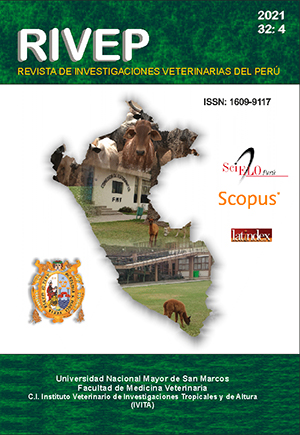Calidad del agua y de la leche en sistemas de ordeño manual de la Sierra Norte del Ecuador
DOI:
https://doi.org/10.15381/rivep.v32i4.20937Palabras clave:
ordeño manual, calidad de agua, calidad de leche, producción de leche, EcuadorResumen
El objetivo del estudio fue determinar la calidad del agua utilizada durante el ordeño manual y su influencia en la calidad microbiológica de la leche. Se trabajó con 63 productores de ganado bovino de comunidades localizadas en Cayambe y Pedro Moncayo en la región Sierra Norte del Ecuador. Las muestras fueron colectadas en las unidades productivas donde realizan el ordeño, en las cuales el 98% no disponía de agua potable. La población fue categorizada en dos grupos: los que utilizan agua potable, transportada en recipientes (G1) y los que utilizan agua colectada de otras fuentes (lluvia o riego) (G2). G1 presentó agua y leche de calidad aceptable: coliformes totales <50 NMP/100 ml; ausencia de coliformes fecales y CBT <200x103 UFC/ml, en tanto que las muestras de agua y leche de G2 presentaron coliformes totales superando los límites permisibles, presencia de coliformes fecales (29%) y CBT >900x103 UFC/ml. En ambos grupos, el análisis en superficie de mesófilos aerobios en los tarros colectores mostró una limpieza inapropiada (>400 UFC/cm2). Se concluye que la calidad del agua utilizada en el ordeño es uno de los factores que incide en la calidad microbiológica de la leche.
Descargas
Descargas
Publicado
Número
Sección
Licencia
Derechos de autor 2021 Rocío Contero, Charles Cachipuendo

Esta obra está bajo una licencia internacional Creative Commons Atribución 4.0.
LOS AUTORES RETIENEN SUS DERECHOS:
a. Los autores retienen sus derechos de marca y patente, y tambien sobre cualquier proceso o procedimiento descrito en el artículo.
b. Los autores retienen el derecho de compartir, copiar, distribuir, ejecutar y comunicar públicamente el articulo publicado en la Revista de Investigaciones Veterinarias del Perú (RIVEP)(por ejemplo, colocarlo en un repositorio institucional o publicarlo en un libro), con un reconocimiento de su publicación inicial en la Revista de Investigaciones Veterinarias del Perú (RIVEP).
c. Los autores retienen el derecho a hacer una posterior publicación de su trabajo, de utilizar el artículo o cualquier parte de aquel (por ejemplo: una compilación de sus trabajos, notas para conferencias, tesis, o para un libro), siempre que indiquen la fuente de publicación (autores del trabajo, revista, volumen, numero y fecha).



